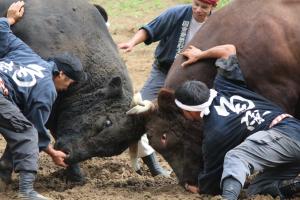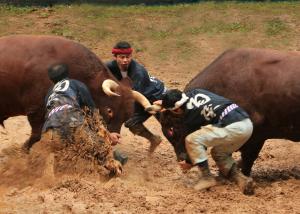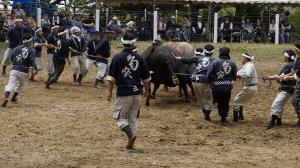Tsunotsuki:Traditional"Bull Sumo"
Tsunotsuki: Traditional “Bull Sumo”
Two powerful bulls face off against each other in a circular arena. Foreheads touching, they push against each other, urged on by their handlers, in a display of strength and determination. Evocative of sumo, tsunotsuki, or “locking horns,” is a form of bullfighting believed to have originated in the mountains of Ojiya. The sport has a thousand-year history with roots in Shinto rituals. In this type of bullfighting, rigorous measures are taken to ensure that the bulls do not become injured or perish. Long, grueling matches are avoided and the judge calls the match.
Tsunotsuki heritage
In the ancient mountain communities of Ojiya, bulls were revered for their indispensable role in transporting goods over long distances and in tilling the terraced rice fields. It is believed that tsunotsuki began here as part of a sacred ritual dedicated to the deities. Like sumo wrestling, the origins of tsunotsuki can be traced back to ancient Shinto rituals.
Nambu shorthorn bulls from Iwate Prefecture have been favored in Ojiya throughout history due to their strong limbs and ability to withstand the region’s long, harsh winters.
Tsunotsuki, Shinto, and sumo
The first tournament of the year commences with purification rituals by a Shinto priest. Before every tournament, the handlers (seko) purify themselves by taking swigs of sacred sake. Sake is then poured over the bulls from tail to head, a gesture that symbolizes the desire for them to move forward instead of backward. In an act of purification, sake and salt are scattered around the arena before the games start.
Matches begin with handlers leading each bull around the arena clockwise. They then lead the bulls toward each other, clapping their hands together or slapping their bull’s rump for encouragement. Once the bulls are in position, the match begins. The bulls lock horns and “wrestle” each other until the judge declares the end of the match and the handlers separate them. Because the bulls are considered sacred animals, strict measures are taken to ensure that they are not injured. If an accident occurs during a match, salt is sprinkled around the arena to purify the site.
Similar to sumo, the highest-ranking bulls compete last during tournaments. The last three matches are known as the shimai-sanban (“last big three”). High-ranking bulls have decorative ropes (omozuna) colored red, white, and black hung around their necks. They symbolize strength, and evoke the ornamental silk aprons worn by sumo wrestlers.
Many aspects of tsunotsuki bullfighting have remained unchanged over the years, leading to its designation as an Important Intangible Folk Cultural Asset of Japan in 1978. Tournaments take place once a month from May to November during which 15 to 20 matches are held in a day.
About Tsunotsuki: Rules, Roles, and Participants
Tsunotsuki, literally “locking horns,” is a competition between two bulls that push each other in a show of strength and stamina. A judge calls the match, and the bulls are evaluated for their vigor and perseverance to determine pairings in future matches. Tournaments are held at the Ojiya arena from May to November.
The rules
Handlers (seko) lead the competing bulls into the arena. After being led clockwise around the ring, the bulls face off and lock horns, pushing each other until a judge declares the end of the match, and handlers jump in to separate them. A match is typically called just before one bull is about to overpower the other. Matches usually last about five minutes, and strict measures are taken to ensure that the bulls do not suffer injuries.
The seko handlers
At the start of a match, seko nudge and urge the bulls forward by slapping them on their rump, cajoling them with loud cries of “yoshitaaa!,” which means “come on!” in the local dialect. If the bulls start to become too aggressive, the match is called, and the seko handlers have the crucial job of prying the bulls apart. The role of the seko requires speed, intuition, and technical skill, including skill with rope and agility in chasing angry bulls to avoid collisions.
The bulls
Nambu shorthorn bulls from Iwate Prefecture are favored for their size and their resilience to Ojiya’s cold winters. These enormous animals make their debut around the age of three, when they normally weigh between 700 to 1,100 kilograms. Some bulls let out a series of throaty roars, called dogoe, as they enter the arena—a sign that they are ready to fight.
The matches
Around 15 to 20 matches per day take place during the tournaments, which are held once a month in Ojiya. The lineup is published a few days ahead of time. The last three games of the day are known as the shimai-sanban (“last big three”), and feature the strongest bulls from previous tournaments. At the last tournament of the year in November, a grand champion is announced. The title is awarded to the bull deemed bravest and most persevering throughout the season.
The bull owners
Individuals, families, friend groups, and companies own the competing bulls. Owning a bull is a full-time commitment, and feeding, brushing, exercising, and cleaning them on a daily basis are all part of the owner’s job. In pre-modern times, bulls often lived under the same roof as their owner, and were considered members of the family because of their role in tilling fields and transporting goods. Now, owners typically keep bulls in the shared barns near the tsunotsuki arena in Ojiya’s Higashiyama district.
The arena
The arena is located in the mountainous Higashiyama area of Ojiya. Open-air seating, covered seating, and box seats are provided. Outside the arena, stalls sell snacks, sake, and tsunotsuki merchandise. Near the venue, there is an enormous bull-shaped boulder that split into two during the Niigata Chuetsu Earthquake in 2004. The rock now serves as a symbol of recovery and a memorial for the people who died in the earthquake.
Tournaments take place once a month from May to November. Check in advance for prices and availability. Live English commentary is available.
Information
Admission (including tax) / General 1,000yen Vip 2,000yen
Parking / Free(space for 300 vehicles)
Once a month in May-November *Held from noon on the first Sunday of the month except in May and August.




※This English-language text was created by the Japan Tourism Agency.















